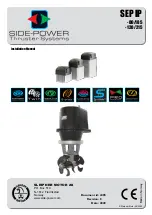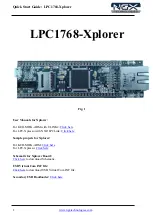
35
The generated system is described using several files. In particular, there is the project file (.qpf),
the top-level Verilog wrapper file (.v) that describes the I/O pins you will use in your design, and
the Quartus II settings file (.qsf) that specifies which pin on the FPGA each I/O in your design
should connect to. A Synopsys Design Constraints (.sdc) file with timing constraints and an HTML
file with pin descriptions will be generated as well.
To proceed with your design, open the Quartus II CAD software and open your newly-created
project. You will now be able to implement the logic of your design by describing your design in a
hardware description language, and connecting it to I/Os in the top-level wrapper file. Once your
design is complete, compile the design using Quartus II, and then use the Quartus II Programmer
tool to configure the FPGA on the DE0-Nano board, using the JTAG programming mode.
Figure 5-1 The general design flow of building a design
Summary of Contents for De0-Nano
Page 1: ...1 ...
Page 4: ...4 9 3 Revision History 155 9 4 Copyright Statement 155 ...
Page 44: ...44 Figure 6 5 Browse to find the location Figure 6 6 There is no need to test the driver ...
Page 90: ...90 Figure 7 14 Add NIOS II Processor ...
Page 93: ...93 Figure 7 17 Rename the CPU 1 Figure 7 18 Rename the CPU 2 ...
Page 98: ...98 Figure 7 23 Add On Chip Memory ...
Page 100: ...100 Figure 7 25 Update Total memory size ...
Page 102: ...102 Figure 7 28 Update CPU settings ...
Page 104: ...104 Figure 7 30 Add PIO ...
Page 106: ...106 Figure 7 32 PIO 21 Rename pio_0 to pio_led as shown in Figure 7 33 Figure 7 33 Rename PIO ...
Page 113: ...113 Figure 7 43 Input verilog Text Figure 7 44 Open DE0_NANO_SOPC v ...
Page 146: ...146 Figure 8 16 Display Progress and Result Information for the SDRAM Demonstration ...
Page 150: ...150 Figure 9 3 Select Devices Page ...
Page 151: ...151 Figure 9 4 Convert Programming Files Page ...
















































